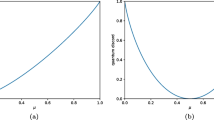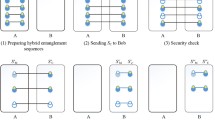Abstract
In this paper, we put forward a novel single-state three-party semiquantum key agreement (SQKA) protocol with three-particle GHZ entangled states first. Different with previous quantum key agreement (QKA) protocols, the proposed single-state three-party SQKA protocol can realize the goal that a quantum party and two classical parties who only possess limited quantum capabilities equally contribute to the generation of a shared private key over quantum channels. Detailed security analysis turns out that the proposed single-state three-party SQKA protocol is secure against several famous attacks from an outside eavesdropper, such as the Trojan horse attack, the entangle-measure attack, the measure-resend attack and the intercept-resend attack. Moreover, it can resist the participant attack, which means that the shared private key cannot be determined fully by any nontrivial subset of three parties. The proposed single-state three-party SQKA protocol has the following nice features: (1) it only employs one kind of three-particle GHZ entangled states as initial quantum resource; (2) it does not need pre-shared keys among different parties; (3) it does not need unitary operations or quantum entanglement swapping. Finally, we generalize the proposed single-state three-party SQKA protocol into the case of \(N\)-party by only employing one kind of \(N\)-particle GHZ entangled states as initial quantum resource, which inherits the nice features of its three-party counterpart.


Similar content being viewed by others
Data Availability Statement
All data and models generated or used during the study appear in the submitted article.
References
Bennett, C.H., Brassard, G.: Quantum cryptography: public key distribution and coin tossing. In: Proceedings of IEEE International Conference on Computers, Systems, and Signal Processing, Bangalore, India, pp.175–179 (1984)
Ekert, A.K.: Quantum cryptography based on Bell’s theorem. Phys. Rev. Lett. 67(6), 661–663 (1991)
Bennett, C.H., Brassard, G., Mermin, N.D.: Quantum cryptography without Bell theorem. Phys. Rev. Lett. 68, 557–559 (1992)
Cabello, A.: Quantum key distribution in the Holevo limit. Phys. Rev. Lett. 85, 5635 (2000)
Deng, F.G., Long, G.L.: Controlled order rearrangement encryption for quantum key distribution. Phys. Rev. A 68, 042315 (2003)
Deng, F.G., Long, G.L.: Bidirectional quantum key distribution protocol with practical faint laser pulses. Phys. Rev. A 70, 012311 (2004)
Long, G.L., Liu, X.S.: Theoretically efficient high-capacity quantum key distribution scheme. Phys. Rev. A 65, 032302 (2002)
Deng, F.G., Long, G.L., Liu, X.S.: Two-step quantum direct communication protocol using the Einstein-Podolsky Rosen pair block. Phys. Rev. A 68, 042317 (2003)
Chen, S.S., Zhou, L., Zhong, W., Sheng, Y.B.: Three-step three-party quantum secure direct communication. Sci. China. Phys. Mech. Astron. 61, 090312 (2018)
Zhou, L., Sheng, Y.B., Long, G.L.: Device-independent quantum secure direct communication against collective attacks. Sci. Bull. 65, 12–20 (2020)
Long, G.L., Zhang, H.R.: Drastic increase of channel capacity in quantum secure direct communication using masking. Sci. Bull. 66, 1267–1269 (2021)
Qi, Z.T., Li, Y.H., Huang, Y.W., et al.: A 15-user quantum secure direct communication network. Light. Sci. Appl. 10, 183 (2021)
Li, T., Long, G.L.: Quantum secure direct communication based on single-photon bell-state measurement. New J. Phys. 22, 063017 (2020)
Sheng, Y.B., Zhou, L., Long, G.L.: One-step quantum secure direct communication. Sci. Bull. 67(4), 367–374 (2022)
Hillery, M., Buzek, V., Berthiaume, A.: Quantum secret sharing. Phys. Rev. A 59, 1829–1834 (1999)
Karlsson, A., Koashi, M., Imoto, N.: Quantum entanglement for secret sharing and secret splitting. Phys. Rev. A 59, 162–168 (1999)
Deng, F.G., Zhou, H.Y., Long, G.L.: Circular quantum secret sharing. J. Phys. A: Gen. Phys. 39(45), 14089–14099 (2007)
Sun, Y., Wen, Q.Y., Gao, F., Chen, X.B., Zhu, F.C.: Multiparty quantum secret sharing based on Bell measurement. Opt. Commun. 282(17), 3647–3651 (2009)
Hao, L., Wang, C., Long, G.L.: Quantum secret sharing protocol with four state Grover algorithm and its proof-of-principle experimental demonstration. Opt. Commun. 284, 3639–3642 (2011)
Zhou, N.R., Zeng, G.H., Xiong, J.: Quantum key agreement protocol. Electron. Lett. 40, 1149–1150 (2004)
Tsai, C.W., Hwang, T.: Quantum key agreement protocol. Technical Report, C-S-I-E, NCKU, Taiwan (2009)
Hsueh, C.C., Chen, C.Y.: Quantum key agreement protocol with maximally entangled states. In: Proceedings of the 14th Information Security Conference (ISC 2004), National Taiwan University of Science and Technology, Taipei, Taiwan, pp.236–242 (2004)
Chong, S.K., Tsai, C.W., Hwang, T.: Improvement on “quantum key agreement protocol with maximally entangled states.” Int. J. Theor. Phys. 50, 1793–1802 (2011)
Shi, R.H., Zhong, H.: Multi-party quantum key agreement with bell states and bell measurements. Quantum Inf. Process. 12, 921–932 (2013)
Liu, B., Gao, F., Huang, W., Wen, Q.Y.: Multiparty quantum key agreement with single particles. Quantum Inf. Process. 12, 1797–1805 (2013)
Yin, X.R., Ma, W.P., Liu, W.Y.: Three-party quantum key agreement with two-photon entanglement. Int. J. Theor. Phys. 52, 3915–3921 (2013)
Xu, G.B., Wen, Q.Y., Gao, F., Qin, S.J.: Novel multiparty quantum key agreement protocol with GHZ states. Quantum Inf. Process. 13, 2587–2594 (2014)
Sun, Z.Y., Yu, J.P., Wang, P.: Efficient multi-party quantum key agreement by cluster states. Quantum Inf. Process. 15, 373–384 (2016)
Zhu, Z.C., Hu, A.Q., Fu, A.M.: Participant attack on three-party quantum key agreement with two-photon entanglement. Int. J. Theor. Phys. 55, 55–61 (2016)
Wang, W., Zhou, B.M., Zhang, L.: The three-party quantum key agreement protocol with quantum Fourier transform. Int. J. Theor. Phys. 59, 1944–1955 (2020)
Boyer, M., Kenigsberg, D., Mor, T.: Quantum key distribution with classical Bob. Phys. Rev. Lett. 99(14), 140501 (2007)
Boyer, M., Gelles, R., Kenigsberg, D., Mor, T.: Semiquantum key distribution. Phys. Rev. A 79(3), 032341 (2009)
Li, C., Yu, K., Kao, S., Hwang, T.: Authenticated semi-quantum key distributions without classical channel. Quantum Inf. Process. 15(7), 2881–2893 (2016)
Meslouhi, A., Hassouni, Y.: Cryptanalysis on authenticated semi-quantum key distribution protocol using Bell states. Quantum Inf. Process. 16(1), 18 (2017)
Zou, X.F., Qiu, D.W., Zhang, S.Y., Mateus, P.: Semiquantum key distribution without invoking the classical party’s measurement capability. Quantum Inf. Process. 14(8), 2981–2996 (2015)
Liu, Z., Hwang, T.: Mediated semi-quantum key distribution without invoking quantum measurement. Annalen der Physik. 1700206 (2018)
Ye, T.Y., Li, H.K., Hu, J.L.: Semi-quantum key distribution with single photons in both polarization and spatial-mode degrees of freedom. Int. J. Theor. Phys. 59(9), 2807–2815 (2020)
Ye, T.Y., Geng, M.J., Xu, T.J., Chen, Y.: Efficient semiquantum key distribution based on single photons in both polarization and spatial-mode degrees of freedom. Quantum Inf. Process. 21, 123 (2022)
Ye, T.Y., Ye, C.Q.: Measure-resend semi-quantum private comparison without entanglement. Int. J. Theor. Phys. 57(12), 3819–3834 (2018)
Lin, P.H., Hwang, T., Tsai, C.W.: Efficient semi-quantum private comparison using single photons. Quantum Inf. Process. 18, 207 (2019)
Xie, C., Li, L., Qiu, D.: A novel semi-quantum secret sharing scheme of specific bits. Int. J. Theor. Phys. 54, 3819–3824 (2015)
Gao, X., Zhang, S., Chang, Y.: Cryptanalysis and improvement of the semi-quantum secret sharing protocol. Int. J. Theor. Phys. 56, 1–9 (2017)
Ye, T.Y., Ye, C.Q.: Circular semi-quantum secret sharing using single particles. Commun. Theor. Phys. 70(12), 15–25 (2018)
Shukla, C., Thapliyal, K., Pathak, A.: Semi-quantum communication: protocols for key agreement, controlled secure direct communication and dialogue. Quantum Inf. Process. 16, 295 (2017)
Ye, T.Y., Ye, C.Q.: Semi-quantum dialogue based on single photons. Int. J. Theor. Phys. 57(5), 1440–1454 (2018)
Liu, W.J., Chen, Z.Y., Ji, S., Wang, H.B., Zhang, J.: Multi-party semi-quantum key agreement with delegating quantum computation. Int. J. Theor. Phys. 56, 3164–3174 (2017)
Zhou, N.R., Zhu, K.N., Wang, Y.Q.: Three-party semi-quantum key agreement protocol. Int. J. Theor. Phys. 59, 663–676 (2020)
Cai, Q.Y.: Eavesdropping on the two-way quantum communication protocols with invisible photons. Phys. Lett. A 351(1–2), 23–25 (2006)
Gisin, N., Ribordy, G., Tittel, W., Zbinden, H.: Quantum cryptography. Rev. Mod. Phys. 74(1), 145–195 (2002)
Deng, F.G., Zhou, P., Li, X.H., et al.: Robustness of two-way quantum communication protocols against Trojan horse attack. https://arxiv.org/abs/quant-ph/0508168 (2005)
Li, X.H., Deng, F.G., Zhou, H.Y.: Improving the security of secure direct communication based on the secret transmitting order of particles. Phys. Rev. A 74, 054302 (2006)
Sun, Z.W., Zhang, C., Wang, B.H., Li, Q., Long, D.Y.: Improvements on “multiparty quantum key agreement with single particles.” Quantum Inf. Process. 12, 3411 (2013)
Acknowledgements
The authors would like to thank the anonymous reviewers for their valuable comments that help enhancing the quality of this paper. Funding by the National Natural Science Foundation of China (Grant No. 62071430 and No. 61871347), the Fundamental Research Funds for the Provincial Universities of Zhejiang (Grant No. JRK21002) and Zhejiang Gongshang University, Zhejiang Provincial Key Laboratory of New Network Standards and Technologies (No. 2013E10012) is gratefully acknowledged.
Author information
Authors and Affiliations
Corresponding author
Additional information
Publisher's Note
Springer Nature remains neutral with regard to jurisdictional claims in published maps and institutional affiliations.
Rights and permissions
About this article
Cite this article
Xu, TJ., Chen, Y., Geng, MJ. et al. Single-state multi-party semiquantum key agreement protocol based on multi-particle GHZ entangled states. Quantum Inf Process 21, 266 (2022). https://doi.org/10.1007/s11128-022-03615-5
Received:
Accepted:
Published:
DOI: https://doi.org/10.1007/s11128-022-03615-5




